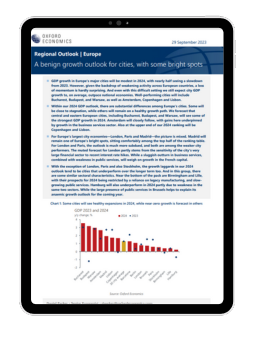A benign growth outlook for European cities, with some bright spots

GDP growth in Europe’s major cities will be modest in 2024, with nearly half seeing a slowdown from 2023. However, given the backdrop of weakening activity across European countries, a loss of momentum is hardly surprising. And even with this difficult setting we still expect city GDP growth to, on average, outpace national economies.
What you will learn:
- Within our 2024 GDP outlook, there are substantial differences among Europe’s cities. Some will be close to stagnation, while others will remain on a healthy growth path. We forecast that central and eastern European cities, including Bucharest, Budapest, and Warsaw, will see some of the strongest GDP growth in 2024.
- For Europe’s largest city economies―London, Paris and Madrid―the picture is mixed. Madrid will remain one of Europe’s bright spots, sitting comfortably among the top half of the ranking table. For London and Paris, the outlook is much more subdued, and both are among the weaker city performers.
- With the exception of London, Paris and also Stockholm, the growth laggards in our 2024 outlook tend to be cities that underperform over the longer term too. And in this group, there are some similar sectoral characteristics. Near the bottom of the pack are Birmingham and Lille, with their prospects for 2024 being restricted by a reliance on legacy manufacturing, and slow-growing public services.
Tags:
Related Posts

Five reasons why European CRE isn’t out of the woods yet
Our view is that European commercial real estate (CRE) is not out of the woods yet, but things are looking better than before the summer.
Find Out More
Higher prices not denting travel recovery in Europe
Services inflation in the Eurozone has remained persistent and within this the price of travel related items such as international flights and hotels have risen significantly this year.
Find Out More
Inflation expectations ease on expected new phase for ECB
Most measures of inflation expectations eased in recent months, with the notable exceptions not as bad as they look. This improvement alleviates concerns about possible second-round effects or an unanchoring of inflation expectations, making it easier for the European Central Bank to bring actual inflation back to its 2% target. This will also facilitate a gradual return from the ECB to a more traditional reaction function after a period where taming high inflation was the sole focus.
Find Out More
Long-term productivity growth drives CEE city economies
Cities in central and eastern Europe (CEE) have grown rapidly since the start of the century, driven by rising productivity. That has more than offset the negative impact for these cities of skilled workers migrating to the west. By 2050, nominal GDP per worker in CEE cities will on average match that in west European cities.
Find Out More